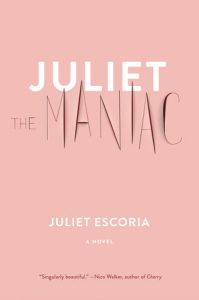by MALLORY FINDLAY

Juliet Escoria, Juliet the Maniac (Melville House, 2019), pp. 336.
Autofiction seemed to have a bit of a moment in 2018 and 2019. Book critics scrambled to define the genre as writers like Karl Ove Knausgaard, Sheila Heti, and Rachel Cusk published works that dramatized events drawn from their lives in a way that wasn’t simply what novelists have been doing all along. These books elude easy categorization; they sidestep the plot and character development of fiction and complicate the straightforward narration of the “facts” of autobiography. The question begged is if the people and events that populate novels have always been based on “real life,” is autofiction even a thing? As they discuss Ben Lerner’s third novel, The Topeka School, Garth Risk Hallberg and Pamela Paul, in an October 2019 episode of the New York Times Book Review podcast, gleefully conclude, “No one’s doing it. We’re all just talking about it.”
Hallberg calls autofiction a category that was only theorized “predictively” because we, the collective literary audience, supposedly tired of the conventions of plot and character—performative techniques in literary fiction. In the age of “I” on social media, an age defined by identity politics that make us suspicious of narrators who look different than their authors, an age obsessed with ferreting out authenticity when the internet makes it easy to curate our experience of reality, we crave writing that garners its authenticity from direct links to writers’ lives. But really, this idea, as Hallberg points out, seems to miss the point. Most novels draw from the writer’s life, however obliquely. They always have.
Juliet Escoria’s 2019 novel, Juliet the Maniac, falls into the autofictive category. It mines events from her adolescence—her struggle with bipolar disorder, her tenure at a therapeutic boarding school—and includes inserts like patient logs, handwritten notes, and journal entries as paratextual supplements to Juliet the character’s narration. We get a photo of the hospital bracelet she wore after her first suicide attempt and a handwritten note to her parents that begins, with the uncanny mix of innocence and frankness only a fifteen-year-old can embody,
“Dear Mom and Dad,
I have been having a hard time lately. Maybe you have noticed.”
The protagonist narrator shares the name of her author, and the plot isn’t quite a plot in the way a novel reader might expect. Where novel readers might look for an inciting event and rising action, Escoria gives us multiple inciting events and their fallouts, with little sense of resolution before moving on to the next. We also might look for an obvious climax, that culmination of breadcrumbs left by the narrator, but Juliet’s struggle with bipolar disorder lends itself more to nadirs, moments where the reader suspects it can’t get any worse for her, before it does. For denouement, she offers a vaguely cathartic scene in a desert in which Juliet understands that humans are just as chaotic and random as stars, the kind of realization that might give a teenager comfort as she grapples with the uncertainty of her identity and the future. In one of the final vignettes, Juliet predicts her future: it will be “suffering” and “grace”, both, because that’s what it’s like to experience the fullness of her humanity, outside the painful confines of her bipolar mind. In this way, her experiences get a retrospective framework. Out of chaos and turbulence, order comes from interpretation.
If you’re going to write about something as unsettling, as sometimes inconceivable to a bystander, as a mood disorder, autofiction makes sense as a medium. Breakdown and mental illness lend themselves especially well to the sometimes fractured and episodic nature of the genre precisely because in their lived experience, they abandon convention. They force expulsion from the normative bounds of “plot” and “character” development that our American culture imposes on teenagers. The compulsion we have towards “high achievement” and recognizable, linear trajectories provokes panic about any unplanned detour from the well-worn path to successful adulthood. Bildungsromans have always documented the uneasiness that comes with maturation, but autofictive storytelling does away with the coming-of-age trope altogether and sends Juliet backwards and forwards, lurching around on a spectrum of development, sometimes unwillingly and blindly. Her plans are hardly deliberate; most of the time, she’s just trying to keep herself alive, maybe even against her own will.

For Juliet, episodes that come with depression, anxiety, mania, drinking, drug addiction, and promiscuity structure her experience of being a teenager, pushing her outside the expected developmental lanes that her peers adhere to as lockstep as a marching band. Meanwhile, Juliet’s going over the side of a cliff, flailing her arms wildly. The days are passing but Juliet is stationary, held captive by her own mind and its horrors. The only things that change are her mood, her location, her friends. She describes isolated events, less interested in the cause-and-effect narrative structure that many novelists rely on to justify the events of their stories.
For these reasons, Escoria’s unconventional novel might read entirely conventionally to someone familiar with mental illness. The most typical of depressed teenage girls with literary aspirations, I devoured Sylvia Plath, Susanna Kaysen, and Elizabeth Wurtzel, hungrily searching for an explanation of what was wrong with me, why I wasn’t like my peers at school, so bright-eyed and energetically achieving things to open up their bright futures. I took comfort in stories of mental darkness, slippery descents. Escoria joins this esteemed group of women writing about breakdowns, women who hated themselves and wanted to die. When you want to die, you don’t do things that promote a future, and we rely on diagnoses to explain the baffling impulse to self-destruct.
The problem, however, with labels, diagnoses, definitions, and prescriptions is how responsive we are to them, how relieved we are to find ourselves in language, defined and delimited, our confusion reduced to a few scribbles on a psychiatrist’s notepad. Part of me has always wondered if we might not feel better sooner if only we did away with these labels and allowed ourselves to be in flux, without trying to explain and justify our moods with chemical imbalances or diagnoses. Escoria’s novel is ambivalent about prescriptions, too, the people who constitute “anyone with an opinion about [her] illness.” Her patient logs interrupt her narration; lists of medications populate her medical history, tried, then discontinued, because of their unwanted side effects, all part of a chemical experiment to find some impossible equilibrium. What her doctors don’t tell her, she says, is
“how much psych meds sucked. They went over the long list of side effects, but
nobody seemed to care when I said yes, the medicine made my stomach hurt and hair fall out and gave me diarrhea and turned everything stupid and flat and boring. The sluggishness, the flat gray of the sky and the old snow, the days all the same, same routine, same people, same dramas. I didn’t want to go back to hearing things and I didn’t want to go back to trying to kill myself, but I also wanted to feel something real and true, life in neon, rather than this dull blanket.”
To feel anything real, Juliet strains against some prescribed medications and yearns for others, eager to mute certain feelings and amplify others. A new psychiatrist at her therapeutic boarding school prescribes her Ativan for insomnia, and Juliet feels like she won “the pharmaceutical lottery.” Wellbutrin, on the other hand, makes her suicidal. Recreational drugs, the ultimate form of self-medication, make her feel the best. Juliet acknowledges, “I know people act like you can’t have any real feelings on drugs, that everything that happens to you on them is a lie,” but riding the high of cocaine “felt like something real, realer than real, electric and on fire.”
Early in the novel, before her bipolar diagnosis, Juliet skips class to find a book on psychiatry in her school library, looking up schizophrenia to see if it explains her hallucinations. The diagnostic criteria fit so perfectly, she slams the book shut and walks out of the building straight home, wanting to escape herself but having nowhere to go. A later chapter, called “Fact Sheet from the Future,” cites eleven articles from sources ranging from Wikipedia to the New York Times to academic journals on the subject of antidepressants and how little was known about their side effects when they were first being prescribed, how research would come to show a correlation between antidepressants and “increased suicidality.”
At first, the diagnosis of bipolar disorder is a comfort, a signal that there are others like her, that she can be fixed. But then it becomes a burden she can’t escape, with its own conventions and plot development, character traits, side effects and symptoms. Like any teenager, Juliet just wants to be normal, figure out her identity. She puts on makeup, dresses up for dances, makes out. She likes to paint her nails and watch movies, and she hates bullies. A boy breaks her heart. But her emotions are out of control. Like those of so many adults, the narrator’s memory of her teenage self “is a movie, with all the scenes out of order, not of myself but of some random girl, a stranger.” That girl is not Juliet; Juliet doesn’t “own her, or know her, but she both owns and knows” Juliet.
The language of Escoria’s novel reads with the stark, unwavering clarity of sensation and opinion that teenagers have, before their brains become clouded with the competing paradigms of the adult world, before they learn to be unsure of themselves, to explain themselves. Juliet tells us exactly what happened to her,what she did, no matter how stark or brutal, how unflattering. With some friends, she looks in a dumpster behind a Walgreens and finds clothes and a full purse, covered in a little blood. They divide up the items. Juliet gets a jacket, a compact mirror, a skirt. She writes,
“We never talked about the things in the dumpster, just looked at each other with secret smiles when we wore the clothes. Whenever people complimented me on my jacket, I just said thank you, but in my head, I added, I got it from a dead woman. I tried to feel bad about it, but it never worked out. I really loved that coat.”
Like the other vignettes, this one describes a discrete episode, disconnected from any narration around it. There’s no meaning to be explained, no causality, no interpretation to be gained, when motivations hardly make sense to the actor herself. If there is no point, language must be direct, interpretive moves limited, as if the narrator and the author lack the motivation or the capability to interpret a life that seems so inexplicable, the mutiny of Juliet’s brain without reason. She can’t tie her teenage actions to some greater narrative arc or the kind of settled, retrospective meaning that memoirists deploy. Things just happened and she’s content to leave it at that.
In this way, the disjointed, digressive vignettes make sense. After a difficult or atypical adolescence, you spend a great deal of your adult life trying to put the pieces together to find meaning, searching for the one moment that will explain why it all went awry, wondering if you could have saved yourself if you’d been more vigilant or had access to better resources. But Juliet lets each episode exist on its own; sometimes one thing leads to another, but mostly nothing pans out the way the reader thinks it will. When Juliet and her friend Christina snort cocaine together at the school, nobody catches them. There are no repercussions, lessons learned, or redemptive moment.
If autofiction is also suspicious that we’re always performing, fraudulent and artful in our daily lives and in our literary production, a mental illness diagnosis is the ultimate testament to what happens when the performance falls away completely. When we give up the cheerful self-satisfaction of our successful roleplaying–the meeting of expectations, the checking of the boxes on the march to normative adulthood–then the neatness of cause-and-effect narrative disappears, too. Juliet the Maniac works against coherent, assured selfhood. Juliet cuts herself because she is “a person who couldn’t stand the simple act of being herself,” sure that everyone else has it figured out. She writes, of this loneliness,
“I couldn’t stop seeing myself as a stranger. All the people around me seemed
to know each other, and they were all in the same world, one different than mine,
one where everyone knew what they were doing and what they wanted.”
In reality, no one knows what they’re doing—they hardly know what they want. But we pretend. To admit how often we make it up as we go, fumbling in the dark, would be to give ourselves over to existential dread. Juliet does give herself over to it; she cries because she feels “the frustration of failing to be someone else”, someone better, healthier, stronger. It is inherently lonely being ourselves, inhabiting our bodies, our brains, severed from others, so certain that everyone else is getting it right, knows what they’re doing. People who suffer from depression and anxiety and bipolar disorder surrender to these fears, these frustrations. Of course, Escoria’s narrator deploys the familiar metaphors of “the foreign thing,” “the dark thing,” “something sick” inside of her (4), but it is her frank engagement with the loneliness of existence that enables performance and convention to fall away.
Escoria’s book ends with Juliet telling us that she wants to lay her maniacal teenage self to rest, but she is haunted by that girl. Haunting is a metaphor writers love. It works well in its literal meaning—the unwanted, regular manifestation of a ghost—but also in its figurative uses—the mental torment that accompanies a memory or an experience that won’t leave us, that follows us into our futures, pulling us back to places and people we wish we could leave behind, be apart from. This is another excellent case for autofiction: Juliet’s sense that we are ourselves inescapable. Autofiction lays bare what much literary fiction tries to mask: writers cannot help but draw on their experiences, what they know. They can do all the research in the world, but in the end, still, they are limited by what their own brains can create. Juliet’s mind betrayed her; she fought against it, tried to kill it—twice. And here she is, wrestling with it still, trying to make sense of it.
And isn’t that how it goes? We strain against and toward our earlier versions, never quite ourselves from one day to the next but always ourselves, of the same brain, in the same body.

